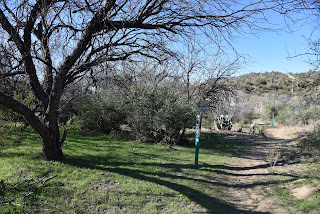STIRRUP-SADDLE UP LOOP
 |
| Cockscomb formation viewed from Saddle Up trail |
Never hike behind a horse. Besides the obvious chance of being sprayed with a steaming-fresh pile of you-know-what, walking behind a horse on a trail is potentially risky business.
Horses simply see the world differently than people. Things like sudden loud noises, fast-moving objects and surprise encounters can set them off, so it’s smart to know the horse drill before setting out on trails frequented by equestrians.
 |
| Western Gateway trails are popular with horses & hikers |
Standard trail protocols dictate that horses always get the right-of-way. Always.
 |
| A dead juniper frames views of Mingus Mountain |
 |
| Know what to do when you meet horses on the trail |
Hikers and bikers are required to yield to horse traffic. But, it’s not just a matter of stepping aside. For safety and courtesy, it’s important to know how to behave during horse encounters on the trail.
Here’s what American Trails, an organization that advances the development of diverse, high quality trails and greenways for the benefit of people and communities, recommends you should do when you meet a horse on a trail.
• Be aware of your surroundings. Ditch the headphones and watch for equine trail users.
• Stop and move aside for oncoming horses, but stay within their sight.
• Keep dogs on a short leash and under control.
• Say hello. Soft speaking signals to the horse that you are not a threat.
• Take directions from the rider. Do not reach out, touch or interfere without permission. Some horses enjoy interacting while others do not.
• When approaching a horse from behind, slow down and quietly announce (do not ring bells, yell or whistle) your presence and wait for instructions from the rider. A startled horse may kick, spin or bolt putting both rider and other trail uses at risk of injury.
• Wait for the horse to pass or, upon the rider’s okay, slowly walk around.
 |
| Town of Jerome visible below snow-capped mountains |
These simple rules ensure happy trails for all.
 |
| The loop passes through a major drainage |
For a chance to apply this course in horse sense, take a stroll on the aptly-named Stirrup-Saddle Up loop in the Western Gateway Area Trails in Sedona.
The hike debarks from the large Girdner trailhead which has room for trailers.
 |
| A walk through a water-ravaged drainage is a highlight of the hike |
Follow the Girdner trail for 0.1-mile, then veer right at the Stirrup trail junction. Shaded by junipers and pinon pines, the easy-rated single track moves north through the riffled watershed of Dry Creek. Wonderful views of the Cockscomb formation, Doe, Bear and Wilson Mountains and the distant profiles of Mingus and Woodchute Mountains rising over the town of Jerome, provide a carousel of eye candy throughout the hike. About a half-mile in, the trail crosses through a rough-cut drainage of sandstone slabs and red-earth walls with protruding roots exposed by flood waters. This brief, oddly-entertaining section lands hikers on a ledge over sprawling green gullies.
 |
| Wilson Mountain viewed from the Stirrup Trail |
At the 0.9-mile point, the trail meets the south terminus of the loop portion of the hike at the Saddle Up junction. Continue north on Stirrup for another 0.7-mile, and pick up the loop at its north junction. The 1.6-mile Saddle Up trail is rated moderate, although it’s only slightly more hilly than its counterpart.
 |
| Cat claw and cacti populate sunny slopes |
High and serpentine, the route passes through acres of thorny, high-desert vegetation. Manzanita, cat claw, yucca and cacti thrive on exposed grasslands favored by scrub jays and ravens.
 |
| R-L: Cockscomb, Doe Mtn, Bear Mtn |
Where the trail bends south, trail users will catch glimpses of iconic Courthouse Butte to the south and the mighty mound of Capitol Butte looming to the east.
 |
| Capitol Butte seen from the Saddle Up trail |
The last leg of the hike passes close to several private horse properties and the Gateway system has many equine access points, so stay alert and be prepared to pony up those trail etiquette protocols at a moment’s notice.
 |
| Horses always have the right-of-way on trails |
LENGTH: 4.1-mile loop
RATING: moderate
ELEVATION: 4,293 – 4,550 feet
GETTING THERE:
Girdner-Cultural Park Trailhead.
From the State Route 89A/179 traffic circle in Sedona, head 4.2 miles west (go left through the circle) on 89A to Cultural Park Way (traffic signal). Turn right and continue 0.3-mile to the Girdner Trailhead on the right. Trailhead has picnic tables and a map kiosk but no restrooms or water.
INFO:
https://www.fs.usda.gov/coconino/
Sharing trails with horses:
American Trails.
https://www.americantrails.org/resources/safe-encounters-with-horses-on-multi-use-trails


















